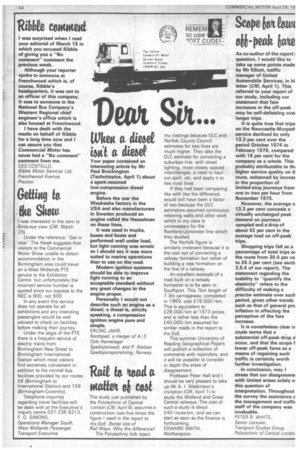Scope kilt tom di Peak bcete
Page 46

If you've noticed an error in this article please click here to report it so we can fix it.
As co-author of the report I question, I would like to take up some points made by Mr Elliott, traffic manager of United Automobile Services, in hi letter (CM, April 1). This referred to your report of our study, including our statement that fare increases in the off-peak may be self-defeating ovel longer trips.
It is quite true that trips on the Newcastle-Morpeth service declined by only 13.3 per cent over the period October 1974 to February 1976, compared with 16 per cent for the company as a whole. This probably attributable to thi higher service quality on tl route, enhanced by increas in the proportion of limited-stop journeys from one to two per hour from November 1975.
However, the average o 13.3 per cent conceals a virtually unchanged peak demand on journeys sampled and a drop of about 42 per cent in the average load on off-peak trips.
Shopping trips fell as a percentage of total trips or the route from 30.4 per ce to 24.3 per cent (see secti, 3.5.4 of our report). The statement regarding the inability to "quantify the elasticity" refers to the difficulty of making a precise estimate over such period, given other trends such as that of general pric inflation in affecting the perception of the fare increase.
It is nonetheless clear in crude terms that a substantial off-peak .drop d occur, and that the scope f lower off-peak fares as a means of regaining such traffic is certainly worth further investigation.
In conclusion, may I stress that our disagreemei with United arises solely a this question of interpretation. Throughout the survey the assistance c the management and traffii staff of the company was invaluable.
PETER R WHITE, Senior Lecturer, Transport Studies Group, Polytechnic of Central Londor




















































































































































































